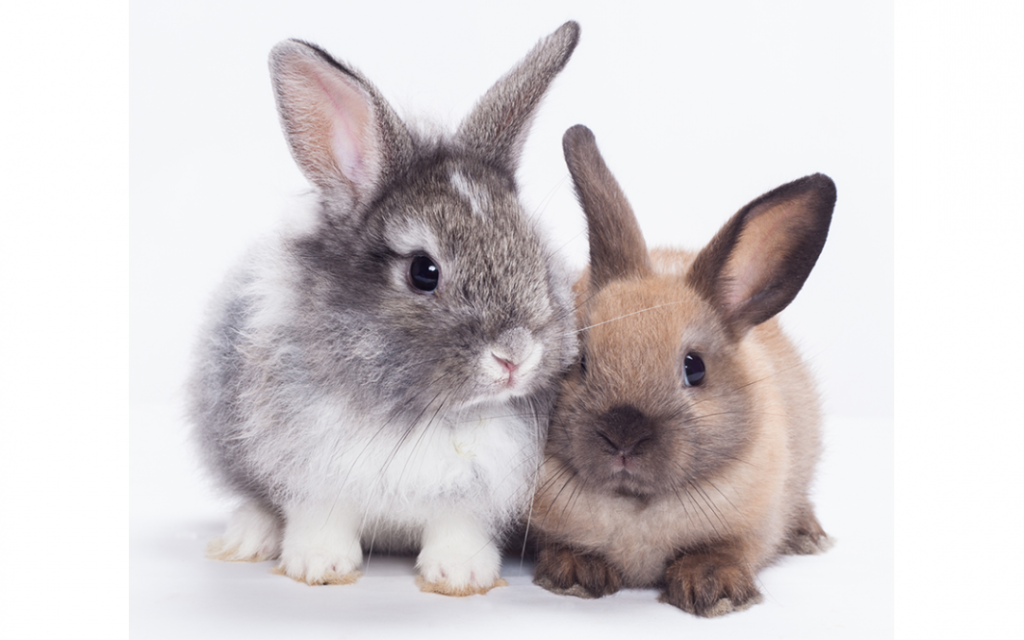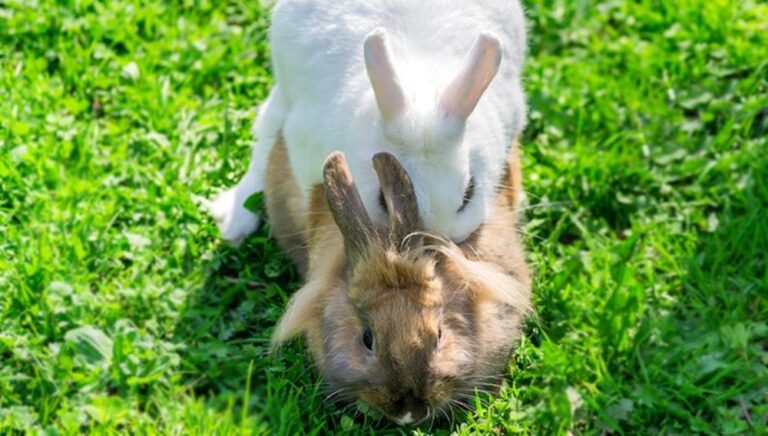Yes, two unneutered female rabbits can live together, but it comes with challenges. Unspayed does are more territorial and may exhibit aggressive behavior. Successful cohabitation depends on factors like their individual personalities, age, and the introduction process. Gradual bonding, patience, and close monitoring are important. If both rabbits are compatible, they can form a strong bond, enjoying each other’s company.
However, it’s essential to be prepared for potential conflicts and seek professional advice if needed. Always prioritize their well-being, provide a safe environment, and consider spaying to reduce hormonal influences and increase the likelihood of a harmonious relationship.
What Influences the Social Structure and Behavior of Rabbits?

Rabbits are social animals that live in groups known as colonies or warrens. However, their social structure is not as rigidly defined as some other animals.
In the wild, rabbits form loose social structures based on a combination of hierarchies and communal living. The basic unit is usually a family group consisting of a dominant male, a dominant female, and their offspring.
Dominance Hierarchy
Within a rabbit group, there is often a dominance hierarchy, where certain individuals have higher social status than others. Dominant rabbits may have priority access to resources such as food, nesting sites, and mates.
Communication
Rabbits communicate through various means, including body language, vocalizations, and scent marking. These communication methods are necessary to interpreting their social interactions. For example, thumping the hind legs on the ground is a warning signal, while purring can indicate contentment.
What Are The Factors Influencing Rabbit Behavior?
Genetics: The behavior of a rabbit is influenced by its genetic makeup. Some breeds may have specific behavioral traits, such as being more sociable or territorial.
Environment: The living environment significantly impacts rabbit behavior. A secure, spacious, and enriching environment is essential for promoting positive behaviors. Lack of stimulation or confined spaces can lead to stress and undesirable behaviors.
Socialization: Early socialization plays a vital role in shaping a rabbit’s behavior. Rabbits that have positive interactions with humans and other rabbits during their early weeks are more likely to be sociable and well-adjusted.
Health: Physical health can impact behavior. Illness or pain may lead to changes in behavior, such as aggression or withdrawal. Regular veterinary check-ups are crucial for maintaining a rabbit’s well-being.
The Significance of Territory in Rabbit Relationships
Territorial Instincts: Rabbits are territorial animals, and they establish territories for feeding, breeding, and shelter. This territorial behavior is more pronounced in wild rabbits, but domestic rabbits also exhibit territorial tendencies.
Marking Behavior: Rabbits mark their territory through scent glands located on their chin, paws, and anal region. They may rub their chin against objects or use fecal pellets to mark their space. These marked territories are essential to prevent stress and conflicts.
Aggression and Territorial Disputes: Intrusions into a rabbit’s territory, especially by unfamiliar rabbits, can lead to aggressive behavior. This aggression serves as a means of defending their space and resources. Caution should be taken when introducing rabbits to each other or changing their living environment.
What Are the Challenges of Keeping Unneutered Female Rabbits Together?

Unneutered female rabbits living together can present unique challenges due to hormonal fluctuations and territorial instincts. Unlike neutered females, unspayed rabbits may exhibit more pronounced territorial behaviors, leading to potential conflicts within the group.
Territorial Aggression
Unspayed female rabbits are more likely to be territorially aggressive, especially in the presence of other females. This can result in disputes over space, resources, and dominance within their living environment.
Reproductive Tensions
The presence of intact females in close quarters may lead to reproductive tensions, as they compete for mates and establish their roles within the hierarchy. This can result in heightened stress levels and disruptive behaviors.
Hormonal Influences on Behavior
Estrous Cycle: Female rabbits go through an estrous cycle, commonly known as being “in heat.” During this cycle, which occurs approximately every 14-16 days, hormonal changes can significantly impact behavior. Unneutered females may become more territorial, restless, and exhibit nesting behaviors.
Increased Aggression: Hormonal fluctuations, particularly during the estrous cycle, can lead to increased aggression among unspayed female rabbits. This aggression is often directed towards perceived rivals, and conflicts may arise over dominance and access to resources.
Potential Conflicts and Aggression
Dominance Struggles
Unneutered female rabbits may engage in dominance struggles, particularly if they are vying for the same resources or territory. This can manifest as chasing, mounting, or even physical fights as they establish their hierarchy.
Stress-Induced Health Issues
Prolonged conflicts and heightened stress levels can have adverse effects on the health of unspayed female rabbits. Stress is associated with a higher risk of gastrointestinal issues, reduced immune function, and overall decreased well-being.
Separation Considerations
In some cases, it may be necessary to separate unneutered female rabbits to prevent continuous conflicts. This is especially crucial if the rabbits are not bonded, as attempts to force cohabitation may result in ongoing stress and aggression.
What Are The Factors Affecting Compatibility?

Age Considerations
Life Stages Impact: The age of rabbits plays a crucial role in their compatibility. Introducing rabbits at similar life stages can result in smoother interactions. Young rabbits (kits) may be more adaptable to bonding, while older rabbits may be more set in their ways and potentially resistant to new companions.
Age-Appropriate Pairings: It’s generally recommended to pair rabbits that are close in age. Large age gaps can lead to misunderstandings in communication and activity levels, affecting the potential for a successful bond.
Individual Personalities of the Rabbits
Temperament Differences: Each rabbit has a unique personality, ranging from outgoing and social to shy and reserved. These individual traits are essential when pairing rabbits. For example, a more dominant rabbit may not pair well with another highly dominant rabbit, leading to conflicts.
Observation and Interaction: Spending time observing the rabbits’ individual behaviors and interactions can provide insights into their personalities. This observation can guide the bonding process, helping to identify potential challenges and strategies for successful pairing.
Introduction Methods and Gradual Bonding
Neutral Territory Introduction: When introducing rabbits, it’s crucial to do so in a neutral territory unfamiliar to both. This helps prevent territorial disputes and reduces the likelihood of immediate aggression.
Supervised Interactions: Initial interactions should be supervised to ensure the safety of the rabbits. Observing their behaviors, such as grooming, sniffing, and neutral postures, can indicate positive progress in the bonding process.
Gradual Bonding: Bonding rabbits is a gradual process that requires patience. Start with short, supervised interactions and gradually increase the time they spend together. This allows the rabbits to become accustomed to each other’s presence and establish a bond at their own pace.
Positive Reinforcement: Reward positive behaviors with treats and praise. This helps create positive associations between the rabbits and reinforces desirable social interactions.
What are the Tips for Successfully Introducing and Bonding Unneutered Female Rabbits?
Step-by-step Guide to Introducing Rabbits
Neutral Territory Introduction: Begin the introduction in a neutral territory unfamiliar to both rabbits. This helps prevent territorial disputes. Also, use a space where neither rabbit has established dominance to reduce the likelihood of aggression.
Supervised Initial Interactions: Keep the initial interactions short and supervised. This allows you to observe their behaviors and intervene if necessary.
Watch for signs of aggression or stress, and separate the rabbits if tensions arise.
Gradual Exposure: Increase the time the rabbits spend together gradually. Start with brief sessions and gradually extend the duration as they become more comfortable with each other.
Parallel Activities: Engage both rabbits in parallel activities, such as eating leafy greens or exploring toys. This creates positive associations with each other’s presence.
Bonding Activities and Exercises
Shared Enclosures
Allow the rabbits to share enclosures gradually, starting with supervised short periods and progressing to longer durations. Moreover, provide multiple hiding spots and separate areas to prevent territorial conflicts.
Grooming Sessions
Rabbits groom each other as a sign of bonding. Facilitate bonding by gently petting and grooming each rabbit, gradually encouraging them to groom each other.
Feeding Together
Share mealtime experiences to promote positive associations. Place food bowls close to each other and gradually reduce the distance between them during meals.
Playtime and Exploration
Encourage bonding through play by introducing toys and objects for exploration. Positive interactions during play can strengthen their bond.
Signs of a Successful Bond
- Mutual Grooming: Mutual grooming is a positive sign of bonding. It indicates that the rabbits have accepted each other and feel secure in their relationship.
- Relaxed Body Language: Observe the body language of the rabbits. Relaxed postures, such as lying down or lounging together, indicate a comfortable and bonded relationship.
- Shared Living Space: If the rabbits willingly share a living space without signs of aggression or tension, it suggests a successful bond.
- Reduced Aggression: A successful bond is characterized by a decrease in aggressive behaviors, such as chasing, mounting, or fighting.
- Sleeping Together: If the rabbits are comfortable enough to sleep in close proximity or cuddle, it is a strong indicator of a well-established bond.
FAQ
Can two unneutered rabbits get along?
Yes, two unneutered rabbits can potentially get along, but it often depends on factors like their individual personalities, proper introductions, and the presence of territorial behaviors.
Can all female rabbits live together?
No, not all female rabbits can seamlessly live together. While some may form bonds, individual personalities, territorial instincts, and proper introductions significantly influence the success of cohabitation.
What gender rabbits can live together?
Both male and female rabbits can live together, but successful cohabitation depends on factors like spaying/neutering, compatibility, and proper bonding techniques.
How do you bond two female rabbits?
Bonding two female rabbits involves gradual introductions in a neutral space, supervised interactions, shared activities, and observing positive behaviors like grooming to encourage a harmonious relationship.
Why are my two female bunnies fighting?
Fighting between two female rabbits can occur due to territorial disputes, competition for resources, or personality clashes. Addressing the root cause and using proper bonding techniques can help mitigate conflicts.
Why do female rabbits refuse to mate?
Female rabbits may refuse to mate due to stress, health issues, or simply being unreceptive to a male’s advances. Ensuring a calm environment and proper introductions can increase mating success.
How long do unspayed rabbits live?
Unspayed rabbits may have a higher risk of reproductive-related health issues, but their lifespan can vary. On average, well-cared-for rabbits, whether spayed or unspayed, can live around 8 to 12 years.
Do unspayed female rabbits bleed?
Yes, unspayed female rabbits can experience bleeding during their reproductive cycle, known as estrus or being “in heat.” This is a normal part of their reproductive behavior.
Final Thoughts
All things considered, having two unneutered female rabbits live together is possible but not without its challenges. It requires a thoughtful approach, considering factors like age and personalities, and following a careful bonding process.
Regular monitoring, readiness for adjustments, and seeking professional advice when needed are important. With patience and the right strategies, creating a harmonious living arrangement for these rabbits is achievable.

